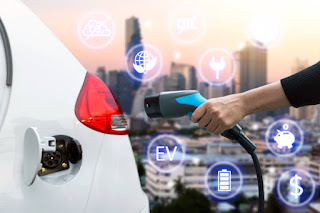Electric vehicle adoption is on the rise, and it's transforming the automotive sector.
Electric vehicles (EVs) have been gaining popularity in recent years, thanks to advancements in technology and a growing awareness of the environmental benefits they offer. In this blog post, we'll explore how EVs are impacting the automotive industry, from the production of cars to the infrastructure that supports them.
Electric vehicles are emerging quickly due to a combination of factors including increasing concerns about air pollution and climate change, advancements in technology that have made electric vehicles more affordable and efficient, and growing consumer interest in sustainable transportation options. Government policies and incentives, such as tax credits and infrastructure development, have also played a role in the increasing popularity of electric vehicles. Additionally, many traditional automakers are investing in the development of electric vehicle models, which has helped to increase the availability and visibility of these vehicles on the market.
Production of EVs:
Traditional car manufacturers, such as Toyota and Ford, are investing in the production of EVs in order to stay competitive in the market. Additionally, new players such as Tesla have entered the market and are now considered major players in the automotive industry.
Battery technology:
The development of better battery technology has been a key factor in the rise of EVs. Lithium-ion batteries, the most common type used in EVs today, have become more efficient and have a longer lifespan, making EVs a more viable option for consumers.
Infrastructure:
As more people are buying EVs, there is a growing need for charging stations and other infrastructure to support them. Governments and private companies are investing in building charging networks and other infrastructure to support the increasing number of EVs on the road.
Environmental impact:
EVs produce zero emissions, making them a cleaner option than traditional gasoline-powered cars. This has led to governments around the world to set targets for the adoption of EVs, in order to reduce carbon emissions and improve air quality.
Future of the automotive industry:
The growth of EVs is expected to continue in the coming years. Some experts predict that by 2040, EVs will make up a significant portion of the cars on the road, and may even become the dominant type of vehicle.
Some examples of electric vehicle models that are growing in popularity include:
1.Tesla Model 3 and Model Y:
These are among the best-selling electric vehicles in the world, with the Model 3 being the best-selling electric car of all time.
2.Nissan Leaf:
The Leaf is one of the most affordable electric vehicles on the market, and has been a popular choice among buyers since its introduction in 2010.
3.BMW i3:
The i3 is a compact electric vehicle that offers a stylish design and a range of up to 153 miles on a single charge.
4.Chevrolet Bolt:
The Bolt is a compact electric vehicle with a range of up to 259 miles on a single charge.
5.Volkswagen ID.4:
The ID.4 is an electric SUV from Volkswagen, with a range of up to 250 miles.
6.Ford Mustang Mach-E:
The Mach-E is an electric SUV from Ford, which has a range of up to 300 miles.
7.Porsche Taycan:
The Taycan is an electric sports car from Porsche, with a range of up to 201 miles.
These are just a few examples of the growing number of electric vehicles available on the market today, many more are available and with different features and specifications.
How Electric vehicles will take over normal vehicles:
Electric cars are expected to become more popular in the coming years as technology improves and costs decrease. Governments around the world are also implementing policies to encourage the adoption of electric vehicles, such as tax incentives and building charging infrastructure. Additionally, as concerns about climate change and air pollution continue to grow, the demand for clean transportation options like electric cars is likely to increase.
Electric vehicles (EVs) are becoming increasingly popular due to their lower operating costs, improved performance, and reduced environmental impact compared to traditional gasoline-powered vehicles. There are several factors that are driving the growth of the EV market:
Government incentives:
Many governments around the world are offering financial incentives to encourage the purchase of EVs, such as tax credits and rebates.
Improvements in battery technology:
Battery technology is improving rapidly, which is leading to longer-range EVs and faster charging times.
Increased availability:
More and more EV models are becoming available from a variety of manufacturers, which is increasing consumer choice and driving down prices.
Greater awareness:
With more and more people becoming aware of the environmental benefits of EVs, demand for these vehicles is increasing.
Cost Competitive:
The cost of batteries and electric motors are decreasing, making the total cost of EVs becoming more competitive with traditional gasoline-powered cars.
As these factors continue to drive the growth of the EV market, it is likely that EVs will eventually overtake traditional gasoline-powered vehicles as the dominant form of transportation. However, it will take time for this transition to occur and it will depend on various factors such as infrastructure development, policies, consumer preferences, and technological advancements.
The rise of electric vehicles is changing the automotive industry in a big way. From production, to battery technology, to infrastructure and environmental impact, EVs are making a big impact. It will be interesting to see how the market develops in the next few years and how it will shape the future of transportation.



.jpeg)






